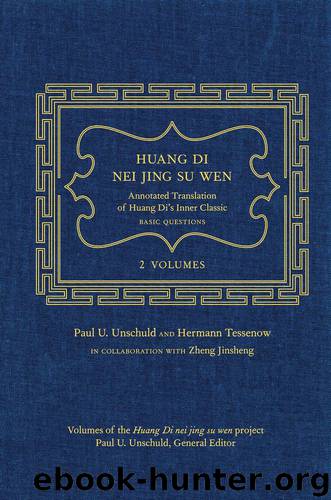Huang Di Nei Jing Su Wen: An Annotated Translation of Huang Di's Inner Classic - Basic Questions by Paul U. Unschuld & Hermann Tessenow

Author:Paul U. Unschuld & Hermann Tessenow
Language: eng
Format: mobi
Tags: Non-Fiction, Social Science, Chinese, Philosophy, Anthropology, Health, Medicine
ISBN: 9780520266988
Publisher: University of California Press
Published: 2011-05-17T23:00:00+00:00
{910} Wang Bing: “散俞 is to say 間穴, ‘holes far apart.’ 分理 is to say 肌肉分理, ‘parting structures between muscles and flesh.’” Lin Yi et al.: “The Si shi ci ni cong lun 四時刺逆從論 (Suwen 64) states: In spring the qi is in the conduit vessels. The 散俞 [mentioned] here refer to the transporter [holes] on the conduit vessels.” Gao Shishi: “散俞 are the transporter [holes] on the network vessels.” Wu Kun: “散俞 are the transporter holes spread all over the back.” Ma Shi: “散俞 are the holes spread over all the conduits.” Tanba: “散俞 are the opposite of 本輸, (i.e., the insertion holes on the conduits in the four extremities between elbows and finger tips and between knees and toes). For example, in view of the major yin conduit associated with the lung, except for the [insertion holes] lesser shang (少商), fish Border (魚際), Great abyss (太淵), Main Conduit Ditch (經渠), and foot Marsh (尺澤), all other holes are ‘holes spread far apart.’ They are called 散俞, ‘scattered transporter [holes].’” Mori: “及与 is not an established expression. 与 and 于 were used interchangeably in antiquity. What [the text is] to say is: in spring one pierces the scattered transporter [holes], neither [too] shallow, nor [too] deep. One just advances towards the parting structures with the blood vessels. The white flesh on the outside of the muscles where one can pierce without the appearance of blood, they are called 肌服, or 肌肉. Those [layers] where, if pierced, blood appears, they are called 分肉, or 分理.”
{911} Zhang Zhicong: “In spring, the qi rises towards the outside. Hence one must apply a shallow piercing in the fossas of the transporter [holes] spread [over the conduit vessels]. As soon as blood appears, the qi in the vessels passes and the disease has come to an end.”
{912} Lun yu 論語, Zi han 子罕, has: 病間. The comment explains: “A light [ailment] is called 間.”(see Ruan Yuan 2490 below). Wang Bing: “One distinguishes whether [the nature of] the pathological qi is light or serious. 傳 is to say 相傳, ‘transmission from one to the next.’ 環 is to say 循環, ‘to follow a circular movement.’ ‘Transmission from one to the next’ means that [a qi is] transmitted into [a conduit/depot by] which it cannot be overcome. ‘Follows a circular movement’ means that it completes a full cycle through [the depots/conduits of all] the five qi.” Lin Yi et al.: “The Tai su has 環已, ‘comes to an end within one circulation period’, instead of 環也. Zhang Jiebin: “傳 is 布散, ‘to spread.’ 環 is 周, ‘cycle.’ In case of severe diseases one lets the needle remain inserted for an extended period of time; hence one must wait until the qi is transmitted. In case of light diseases, one simply waits until the qi has undergone one circulation through the body. This takes about two quarters [of a double hour; i.e. One hour]. Then the piercing can be finished.” 2719/7: “It really does not make any
Download
This site does not store any files on its server. We only index and link to content provided by other sites. Please contact the content providers to delete copyright contents if any and email us, we'll remove relevant links or contents immediately.
Periodization Training for Sports by Tudor Bompa(8170)
Why We Sleep: Unlocking the Power of Sleep and Dreams by Matthew Walker(6618)
Paper Towns by Green John(5091)
The Immortal Life of Henrietta Lacks by Rebecca Skloot(4526)
The Sports Rules Book by Human Kinetics(4294)
Dynamic Alignment Through Imagery by Eric Franklin(4118)
ACSM's Complete Guide to Fitness & Health by ACSM(3989)
Kaplan MCAT Organic Chemistry Review: Created for MCAT 2015 (Kaplan Test Prep) by Kaplan(3940)
Introduction to Kinesiology by Shirl J. Hoffman(3726)
Livewired by David Eagleman(3684)
The Death of the Heart by Elizabeth Bowen(3552)
The River of Consciousness by Oliver Sacks(3541)
Alchemy and Alchemists by C. J. S. Thompson(3451)
Bad Pharma by Ben Goldacre(3357)
Descartes' Error by Antonio Damasio(3230)
The Emperor of All Maladies: A Biography of Cancer by Siddhartha Mukherjee(3068)
The Gene: An Intimate History by Siddhartha Mukherjee(3048)
The Fate of Rome: Climate, Disease, and the End of an Empire (The Princeton History of the Ancient World) by Kyle Harper(3003)
Kaplan MCAT Behavioral Sciences Review: Created for MCAT 2015 (Kaplan Test Prep) by Kaplan(2940)
